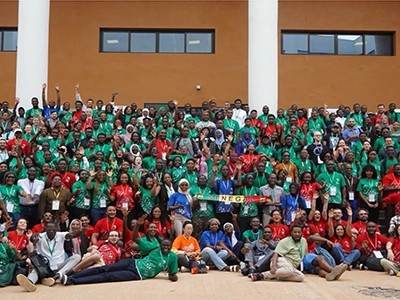
Saudi Arabia is among the countries banking on home-grown AI development.Credit: Fayez Nureldine/AFP/Getty
Coinciding with US President Donald Trump’s tour of Gulf states last week, Saudi Arabia announced that it is embarking on a large-scale artificial intelligence (AI) initiative. The proposed venture will have state backing and considerable involvement from US technology firms. It is the latest move in a global expansion of AI ambitions beyond the existing heartlands of the United States, China and Europe. However, as Nature India, Nature Africa and Nature Middle East report in a series of articles on AI in low- and middle-income countries (LMICs) published on 21 May (see go.nature.com/45jy3qq), the path to home-grown AI doesn’t need to be paved with billions, or even hundreds of millions, of dollars, or depend exclusively on partners in Western nations or China.
Saudi Arabia’s initiative is undoubtedly substantial. The country has established an AI company called HUMAIN in Riyadh, to be chaired by Prime Minister Mohammed bin Salman. Further details had not been made public by the time this Editorial went to press, although we do know that major US tech corporations are closely involved.
As AI giants duel, the Global South builds its own brainpower
Chip-maker NVIDIA in Santa Clara, California, announced that it will supply “several hundred thousand” of its most advanced graphics processing units over five years. Qualcomm, a semiconductor manufacturer in San Diego, California, will build an AI data institute as well as a centre for semiconductor design. Cloud-computing company Amazon Web Services (AWS) in Seattle, Washington, will also be providing AI infrastructure. AWS has announced that it will train 100,000 people in AI and data science, and other firms will follow suit.
However, as a News Feature that appears in the series makes plain (see go.nature.com/3yrd3u2), many initiatives in LMICs aren’t focusing on scaling up, but on ‘scaling right’. They are “building models that work for local users, in their languages, and within their social and economic realities”.
More such local initiatives are needed. Some of the most popular AI applications, such as OpenAI’s ChatGPT and Google Gemini, are trained mainly on data in European languages. That would mean that the model is less effective for users who speak Hindi, Arabic, Swahili, Xhosa and countless other languages. Countries are boosting home-grown apps by funding start-up companies, establishing AI education programmes, building AI research and regulatory capacity and through public engagement.
Those LMICs that have started investing in AI began by establishing an AI strategy, including policies for AI research. However, as things stand, most of the 55 member states of the African Union and of the 22 members of the League of Arab States have not produced an AI strategy. That must change.
Grow AI locally
India provides one example of what can be possible with a vision and (relatively) modest amounts of funding. The country’s Department for Science and Technology has funded an AI initiative, called BharatGen, at a number of Indian Institutes of Technology (IITs), led by IIT Bombay. Trained on local data, BharatGen’s language models will enable users to have human-like conversations using both speech and text in several languages spoken in India, including Hindi and English. This project is one of several that have come about in response to calls from the government for AI research proposals.
Africa leading the global effort for AI that works for all
South Africa is currently consulting on a national AI strategy. At its heart is a plan to establish dedicated AI research centres along with funding for scientists and start-ups. The country’s proposals also aim to improve public understanding of how AI models work. As AI technologies become more and more ubiquitous, increased public awareness (not only in LMICs) is needed so that people can appreciate the benefits and be made aware of the potential dangers of incorrect outputs, and other such limitations.
This is crucial if AI technologies are to assist global development. Jake Okechukwu Effoduh, a researcher at Toronto Metropolitan University in Canada, who studies how AI is being used in African countries, talked to dairy farmers in Kenya who were using machine vision and image-recognition software to detect diseases in cows. The initial excitement of getting an instant diagnosis gave way to disappointment when farmers realized that the app was incorrectly diagnosing otherwise-healthy cattle as being undernourished. This is because the software had been trained on breeds, such as Angus and Hereford, that are larger than those commonly reared in Kenya. “Trust in the model was undermined by a lack of clarity about what is causing these misdiagnoses,” Effoduh explained in a report accompanying his research (see go.nature.com/43nzugs).
According to one 2024 analysis, countries in Africa, South America and Asia — excluding notable big hitters such as China and Japan — collectively produced less than 5% of the world’s AI research (see go.nature.com/3scvs1c). Saudi Arabia’s entry into the mix will help to shift that figure. In other countries, as the series in Nature India, Nature Africa and Nature Middle East demonstrates, providing relatively modest funding to support researchers who have exciting and innovative ideas can go a long way to establishing home-grown AI technologies.




